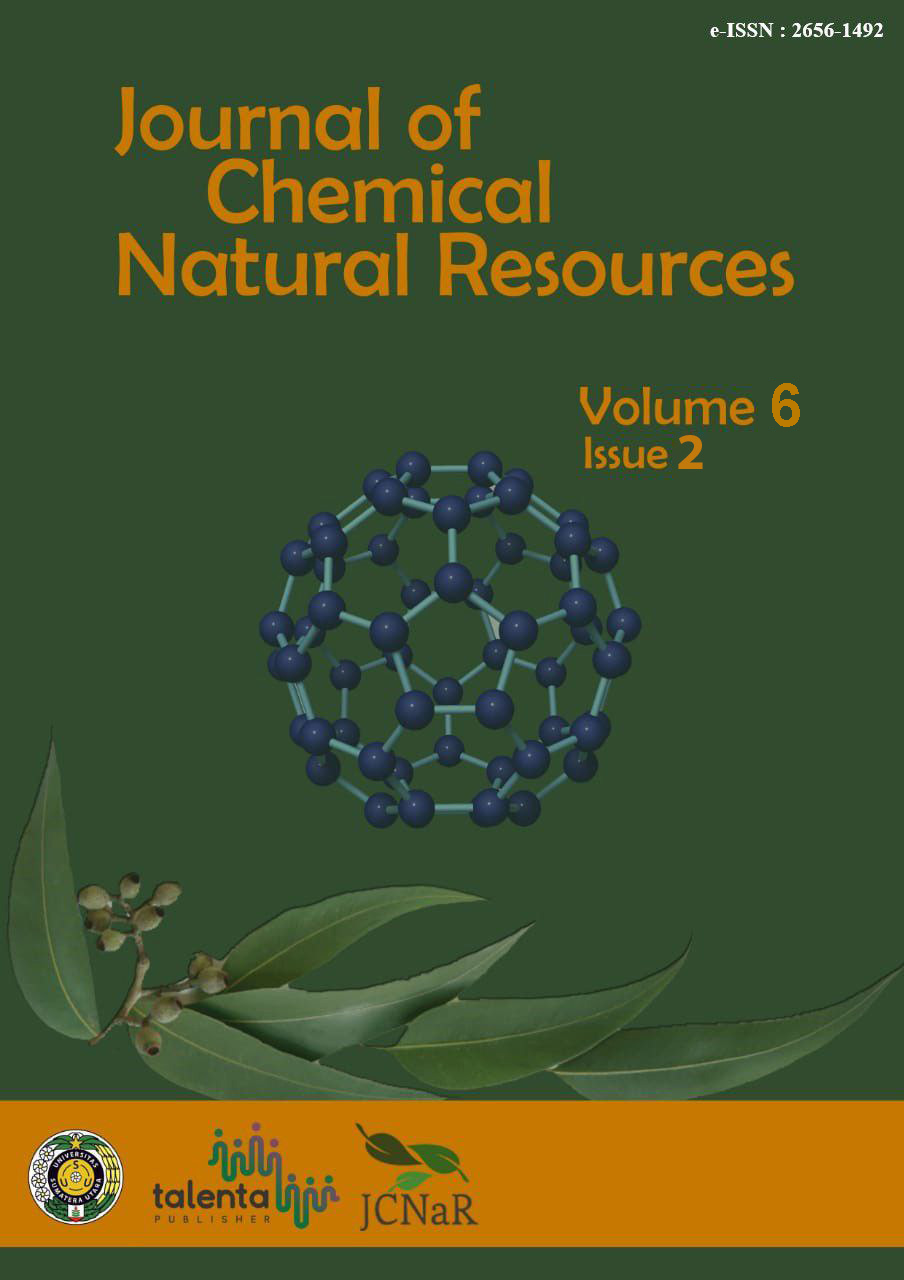Enzymatization of Nila Fish (Oreochromis Niloticus) Protein Hydolysate by Combination of Bromelin and Pepsin Enzymes
DOI:
https://doi.org/10.32734/jcnar.v6i2.18375Keywords:
Amino Acids, Antibacterial, Enzymatic, Nila Tilapia, Protein HydrolysateAbstract
Nile Tilapia (Oreochromis niloticus) is a freshwater fish with better nutritional content compared to other freshwater fish, making it suitable for use as a source for protein hydrolysate production. Protein hydrolysate is the result of the breakdown of protein into short-chain compounds through hydrolysis. This research aims to hydrolyze the minced Nile tilapia meat using a combination of bromelain and pepsin enzymes at a concentration of 5% and pH 7 conditions for 5-6 hours. The hydrolysis results using the combination of bromelain and pepsin enzymes (B100: P0) have a yield value of 12.68%, ash content of 2.94%, protein of 57.25%, water 2.65%, and fat 10.25% with a degree of hydrolysis of 61.46%. The hydrolysate has antibacterial properties against Staphylococcus aureus and Escherichia coli bacteria with inhibition zones of approximately 8.3 mm and 8.5 mm, respectively, at a concentration of 1 (mg/µL), contains 15 types of amino acids with the highest composition being lysine 5.12% and the highest non-essential amino acid being aspartic acid 5.75%.
Downloads
References
M. Shamloo, J. Bakar, D. Mat Hashim, and A. Khatib, “Biochemical properties of red tilapia (Oreochromis niloticus) protein hydrolysates,†Int. Food Res. J., vol. 19, no. 1, pp. 183–188, 2012.
A. A. Prihanto, R. Nurdiani, and A. D. Bagus, “Production and characteristics of fish protein hydrolysate from parrotfish (Chlorurus sordidus) head,†PeerJ, vol. 2019, no. 12, pp. 1–16, 2019, doi: 10.7717/peerj.8297.
R. J. S. De Castro and H. H. Sato, “Comparison and synergistic effects of intact proteins and their hydrolysates on the functional properties and antioxidant activities in a simultaneous process of enzymatic hydrolysis,†Food Bioprod. Process., vol. 92, no. 1, pp. 80–88, 2014, doi: 10.1016/j.fbp.2013.07.004.
O. L. Tavano, “Protein hydrolysis using proteases: An important tool for food biotechnology,†J. Mol. Catal. B Enzym., vol. 90, pp. 1–11, 2013, doi: 10.1016/j.molcatb.2013.01.011.
T. Yuniarti et al., “Formulation and organoleptic characteristics of flavor enhancer from shrimp head protein hydrolysate,†Food Res., vol. 8, no. 1, pp. 148–159, 2024, doi: 10.26656/fr.2017.8(1).331.
Y. Dinakarkumar, S. Krishnamoorthy, G. Margavelu, G. Ramakrishnan, and M. Chandran, “Production and characterization of fish protein hydrolysate: Effective utilization of trawl by-catch,†Food Chem. Adv., vol. 1, no. February, p. 100138, 2022, doi: 10.1016/j.focha.2022.100138.
A. N. F. Palla, Metusalach, and N. Amir, “Protein Hydrolyzate of Grouper Viscera : Effects of Crude Bromelain Extract Concentration and Hydrolysis Time on Yield and Degree of Hydrolysis,†Int. J. Appl. Biol., vol. 6, no. 2, pp. 222–229, 2022.
Y. Witono, M. Maryanto, I. Taruna, A. D. Masahid, and K. Cahyaningati, “Aktivitas Antioksidan Hidrolisat Protein Ikan Wader (Rasbora jacobsoni) Dari Hidrolisis Oleh Enzim Calotropin dan Papain,†J. Agroteknologi, vol. 14, no. 01, p. 44, 2020, doi: 10.19184/j-agt.v14i01.14817.
L. Pinto, M. R. Tapia-RodrÃguez, F. Baruzzi, and J. F. Ayala-Zavala, “Plant Antimicrobials for Food Quality and Safety: Recent Views and Future Challenges,†Foods, vol. 12, no. 12, 2023, doi: 10.3390/foods12122315.
et al., “Aktivitas Antibakteri Dan Antioksidan Hidrolisat Hasil Hidrolisis Protein Susu Kambing Dengan Ekstrak Kasar Bromelin,†J. Teknol. dan Ind. Pangan, vol. 26, no. 2, pp. 179–188, 2015, doi: 10.6066/jtip.2015.26.2.179.
I. Wijayanti, R. Romadhon, and L. Rianingsih, “Karakteristik Hidrolisat Protein Ikan Bandeng (Chanos Chanos Forsk) Dengan Konsentrasi Enzim Bromelin Yang Berbeda Caracteristic of Milkfish (Chanos chanos Forsk) Protein Hydrolysate as effect of Different Bromelin Enzyme Concentration,†SAINTEK Perikan. Indones. J. Fish. Sci. Technol., vol. 11, no. 2, p. 129, 2016, doi: 10.14710/ijfst.11.2.129-133.
M. Nikoo, J. M. Regenstein, and and Mehran Yasemi, “Protein Hydrolysates from Fishery Processing By-Products :,†Foods, pp. 1–28, 2023.
Muhammad Athoillah Sholahuddin, N. D. R. Lastuti, and M. Amin, “Effect of Differences Bromelain Enzyme Consentration on Protein Hydrolysate from Waste of Tilapia Viscera (Oreochromis Sp.) on Antioxidant Activity,†J. Biosains Pascasarj., vol. 26, no. 1, pp. 15–22, 2024, doi: 10.20473/jbp.v26i1.2024.15-22.
P. H. Riyadi, E. Suprayitno, A. Aulanni’am, and T. D. Sulistiyati, “Chemical characteristics and amino acids profile of protein hydrolysates of Nile Tilapia (Oreochromis niloticus) Viscera,†J. World’s Poult. Res., vol. 9, no. 4, pp. 324–328, 2019, doi: 10.36380/SCIL.2019.WVJ41.
M. Nikoo, J. M. Regenstein, A. Haghi Vayghan, and N. Walayat, “Formation of Oxidative Compounds during Enzymatic Hydrolysis of Byproducts of the Seafood Industry,†Processes, vol. 11, no. 2, pp. 1–16, 2023, doi: 10.3390/pr11020543.
Kurniawan, S. Lestari, and S. Hanggita, “Hidrolisis Protein Tinta Cumi-Cumi (Loligo Sp) Dengan Enzim Papain,†FishtecH, vol. 1, no. 1, pp. 41–54, 2012, doi: 10.36706/fishtech.v1i1.796.
H. Haslaniza, M. Y. Maskat, W. M. Wan Aida, and S. Mamot, “The effects of enzyme concentration, temperature and incubation time on nitrogen content and degree of hydrolysis of protein precipitate from cockle (Anadara granosa) meat wash water,†Int. Food Res. J., vol. 17, no. 1, pp. 147–152, 2010.

Downloads
Published
Issue
Section
License
Copyright (c) 2024 Journal of Chemical Natural Resources

This work is licensed under a Creative Commons Attribution-ShareAlike 4.0 International License.














